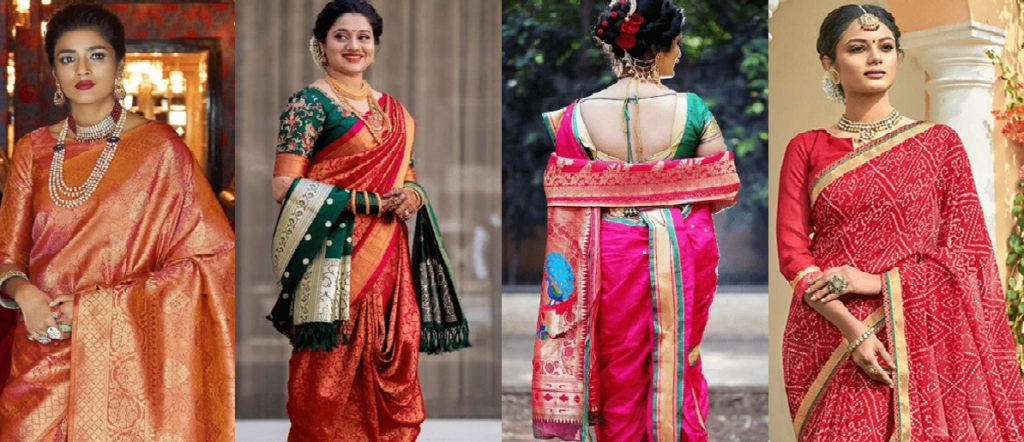
Intricate Elegance: Traditional Sarees of India’s Regions
India is a land of rich cultural diversity, and one of the most iconic symbols of its cultural heritage is the traditional saree. Each Indian state boasts its unique style of saree, reflecting the distinctiveness of its culture, history, and craftsmanship. Here’s a glimpse into the traditional sarees of some Indian states:
- Banarasi Saree (Uttar Pradesh): Originating from the city of Varanasi, Banarasi sarees are renowned for their opulent silk fabric and intricate zari work. They often feature motifs inspired by Mughal art, such as floral patterns, paisleys, and intricate brocades.
- Kanjivaram Saree (Tamil Nadu): Kanjivaram sarees are crafted in Kanchipuram, Tamil Nadu, using pure mulberry silk. They are characterized by their vibrant colors, heavy golden borders, and contrasting pallus. Traditional motifs like peacocks, temples, and checks adorn these sarees, making them a favorite for weddings and special occasions.
- Paithani Saree (Maharashtra): Hailing from the town of Paithan in Maharashtra, Paithani sarees are handwoven using lustrous silk and adorned with intricate zari borders and motifs. They are known for their vibrant colors, especially the use of rich hues like peacock green, magenta, and royal blue. The pallu often features peacock and lotus motifs.
- Kasavu Saree (Kerala): Kasavu sarees are traditional handwoven sarees from Kerala, typically made of cotton. They are characterized by their off-white or cream-colored fabric with golden zari borders. These sarees are often worn on festive occasions and weddings in Kerala.
- Chanderi Saree (Madhya Pradesh): Chanderi sarees, originating from the town of Chanderi in Madhya Pradesh, are known for their lightweight texture and sheer fabric. They are crafted from silk, cotton, or a blend of both, and adorned with delicate zari work or traditional motifs like peacocks, coins, and floral designs.
- Bandhani Saree (Gujarat): Bandhani sarees, also known as Bandhej sarees, are a specialty of Gujarat. They are crafted using the tie and dye technique, where small patterns are tied with threads before dyeing, resulting in vibrant and intricate designs. Bandhani sarees are popular for their bright colors and unique patterns.
- Assam Silk Saree (Assam): Assam Silk sarees, particularly the Muga and Eri varieties, are indigenous to Assam. Muga silk sarees are known for their golden luster and durability, while Eri silk sarees have a soft texture. These sarees often feature motifs inspired by Assamese culture, such as traditional Assamese motifs, animals, and nature.
These are just a few examples of the rich tapestry of traditional sarees found across India, each reflecting the unique heritage and craftsmanship of its respective region.